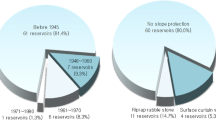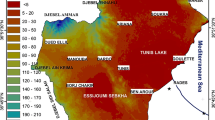Abstract
Environmental risk assessment (ERA) is a commonly used, effective tool applied to reduce adverse effects of environmental risk factors. In this study, ERA was investigated using the Bayesian network (BN) model based on a hierarchical structure of variables in an influence diagram (ID). ID facilitated ranking of the different alternatives under uncertainty that were then used to evaluate comparisons of the different risk factors. BN was used to present a new model for ERA applicable to complicated development projects such as dam construction. The methodology was applied to the Gabric Dam, in southern Iran. The main environmental risk factors in the region, presented by the Gabric Dam, were identified based on the Delphi technique and specific features of the study area. These included the following: flood, water pollution, earthquake, changes in land use, erosion and sedimentation, effects on the population, and ecosensitivity. These risk factors were then categorized based on results from the output decision node of the BN, including expected utility values for risk factors in the decision node. ERA was performed for the Gabric Dam using the analytical hierarchy process (AHP) method to compare results of BN modeling with those of conventional methods. Results determined that a BN-based hierarchical structure to ERA present acceptable and reasonable risk assessment prioritization in proposing suitable solutions to reduce environmental risks and can be used as a powerful decision support system for evaluating environmental risks.








Similar content being viewed by others
References
Adnan, D. (2009). Modeling and reasoning with Bayesian networks. New York: Cambridge University Press.
Castelletti, A., & Soncini-Sessa, R. (2007). Bayesian networks and participatory modelling in water resource management. Environmental Modelling and Software, 22, 1075–1088.
Chen, S., Chen, B., & Fath, B. D. (2013). Ecological risk assessment on the system scale: a review of state-of-the-art models and future perspectives. Ecological Modelling, 250, 25–33.
Dalkey, N. C., & Helmer, O. (1963). An experimental application of the Delphi method to the use of experts. Management Science, 9(3), 458–467.
Faridah-Hanum, I., Latiff, A., Hakeem, K. R., & Ozturk, M. (2014). Mangrove ecosystems of Asia: status, challenges and management strategies. New York: Springer.
Fenton, N. E., & Neil, M. (2012). Risk assessment and decision analysis with Bayesian networks. Boca Raton: CRC Press.
Hamby, D. M. (1994). A review of techniques for parameter sensitivity analysis of environmental models. Environmental Monitoring and Assessment, 32(2), 135–154.
Heller, S. (2006). Managing industrial risk having a tested and proven system to prevent and assess risk. Journal of Hazardous Materials, 130(1–2), 58–63.
Hormozgan regional water company. (2012). Specifications of dams province.
Howes, A. L., Maron, M., & McAlpine, C. A. (2010). Bayesian networks and adaptive management of wildlife habitat. Conservation Biology, 24(4), 974–983.
Karami, A., & Johansson, R. (2014). Utilization of multi attribute decision making techniques to integrate automatic and manual ranking of options. Journal of Information Science and Engineering, 30(2), 519–534.
Kazantzi, V., Gerogiannis, V. C., & Anthopoulos, L. (2013). Multi-criteria decision making for supplier selection in biomass supply networks for bioenergy production in outsourcing management for supply chain operations and logistics service (pp. 313–343). Hershey: IGI Global.
Keshtkar, A. R., Salajegheh, A., Sadoddin, A., & Allan, M. G. (2013). Application of Bayesian networks for sustainability assessment in catchment modeling and management (case study: the Hablehrood river catchment). Ecological Modelling, 268, 48–54.
Korb, K. B., & Nicholson, A. E. (2004). Bayesian artificial intelligence. Boca Raton: Chapman and Hall/CRC Press.
Landuyt, D., Broekx, S., D'hondt, R., Engelen, G., Aertsens, J., & Goethals, P. (2013). A review of Bayesian belief networks in ecosystem service modelling. Environmental Modelling and Software, 46, 1–11.
Lar Consulting Engineers. (2012). Updating report and completing studies of environmental impact assessment of the Gabric Dam. Tehran: Lar Consulting Engineers.
Lein, J. K. (2002). Integrated environmental planning. Oxford, Madlen, Victoria, Berlin: Black Well Science Ltd..
Malekmohammadi, B., & Rahimi Blouchi, L. (2014). Ecological risk assessment of wetland ecosystems using multi criteria decision making and geographic information system. Ecological Indicators, 41, 133–144.
Malekmohammadi, B., Kerachian, R., & Zahraie, B. (2009). Developing monthly operating rules for a cascade system of reservoirs: application of Bayesian network. Environmental Modelling and Software, 24(12), 1420–1432.
McCann, R. K., Marcot, B. G., & Ellis, R. (2007). Bayesian belief networks: application in ecology and natural resource management. Canadian Journal of Forest Research, 36, 3053–3062.
Morales-Nápoles, O., Delgado-Hernández, D. J., De-León-Escobedo, D., & Arteaga-Arcos, J. C. (2014). A continuous Bayesian network for earth dams’ risk assessment: methodology and quantification. Structure and Infrastructure Engineering, 10(5), 589–603.
Nagarajan, R., Marco, S., & Sophie, L. (2013). Bayesian networks in R with applications in systems biology. Berlin: Springer.
Newton, A. C. (2010). Use of a Bayesian network for Red Listing under uncertainty. Environmental Modelling & Software, 25(1), 15–23.
Nyberg, J. B., Marcot, B. G., & Sulyma, R. (2006). Using Bayesian belief networks in adaptive management. Canadian Journal of Forest Research, 36(12), 3104–3116.
Pang, A. P., & Sun, T. (2014). Bayesian networks for environmental flow decision-making and an application in the Yellow River estuary, China. Hydrology and Earth System Sciences, 18(5), 1641–1651.
Peng, M., & Zhang, L. M. (2012). Analysis of human risks due to dam-break floods—part 1: a new model based on Bayesian networks. Natural Hazards, 64(1), 903–933.
Pollino, C. A., & Hart, B. T. (2008). Developing Bayesian network models within a risk assessment framework. Australia: International Congress on Environmental Modelling and Software.
Pollino, C. A., White, A. K., & Hart, B. T. (2007a). Examination of conflicts and improved strategies for the management of an endangered eucalypt species using Bayesian networks. Ecological Modelling, 201, 37–59.
Pollino, C. A., Woodberry, O., & Nicholson, A. K. (2007b). Parameterisation and evaluation of a Bayesian network for use in an ecological risk assessment. Environmental Modelling & Software, 22(8), 1140–1152.
Pourret, O., Naim, P., & Marcot, B. (2008). Bayesian networks: a practical guide to applications. Hoboken: John Wiley & Sons, Ltd.
Reckhow, K. H. (2010). Bayesian networks for the assessment of the effect of urbanization on stream macroinvertebrates. In: Proceedings of the 43rd Hawaii International Conference on System Sciences.
Schubert, M., Hoj, N. P., Ragnoy, A., & Buvik, H. (2012). Risk assessment of road tunnels using Bayesian networks. Procedia - Social and Behavioral Sciences, 48, 2697–2706.
Shin, J., Ajmal, M., Yoo, J., & Kim, T. (2016). A Bayesian network-based probabilistic framework for drought forecasting and outlook. Advances in Meteorology, 2016, 9472605 10 pages.
Smith, M. (2006). Dam risk analysis using Bayesian networks. Engineering Conferences International Proceedings Geohazards.
Sujak, A., Kusz, A., Rymarz, & Kitowski, I. (2016). Environmental bioindication studies by Bayesian network with use of grey heron as model species. Environmental Modeling and Assessment, 22, 103–113. https://doi.org/10.1007/s10666-016-9524-4.
Sun, Z., & Müller, D. (2012). A framework for modeling payments for ecosystem services with agent based models, bayesian belief networks and opinion dynamics models. Environmental Modelling & Software, 45, 15–28.
Watthayu, W., & Peng, Y. (2004). A Bayesian network based framework for multi-criteria decision making, In: Proceedings of the 17 th International Conference on Multiple Criteria Decision Analysis. Whistler, British Columbia, Canada, pp. 6–11.
Wu, W., Yang, C., Chang, J., Château, P., & Chang, Y. (2015). Risk assessment by integrating interpretive structural modeling and Bayesian network, case of offshore pipeline project. Reliability Engineering & System Safety, 142, 515–524.
Xu, Y., Zhang, L. M., & Jiac, J. S. (2011). Diagnosis of embankment dam distresses using Bayesian networks. Part II. Diagnosis of a specific distressed dam. Canadian Geotechnical Journal, 48(11), 1645–1657.
Zhang, L., Wu, X., Qin, Y., Skibniewski, M. J., & Liu, W. (2016). Towards a fuzzy Bayesian network based approach for safety risk analysis of tunnel-induced pipeline damage. Risk Analysis, 36(2), 278–301.
Acknowledgments
The authors would like to thank the two reviewers for their constructive comments on correction and improvement of the manuscript. The authors would like to express their gratitude to the technical experts of the Regional Water Company of Hormozgan Province and Lar Consulting Engineers for providing data and technical assistance.
Author information
Authors and Affiliations
Corresponding author
Rights and permissions
About this article
Cite this article
Malekmohammadi, B., Tayebzadeh Moghadam, N. Application of Bayesian networks in a hierarchical structure for environmental risk assessment: a case study of the Gabric Dam, Iran. Environ Monit Assess 190, 279 (2018). https://doi.org/10.1007/s10661-018-6609-3
Received:
Accepted:
Published:
DOI: https://doi.org/10.1007/s10661-018-6609-3




